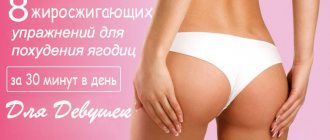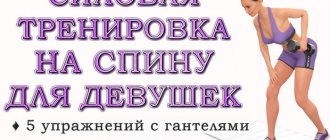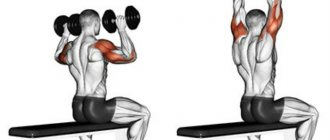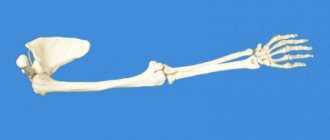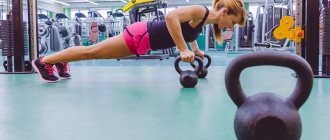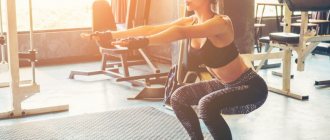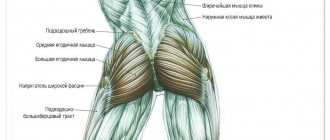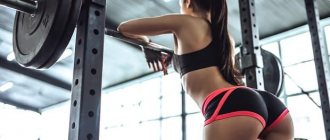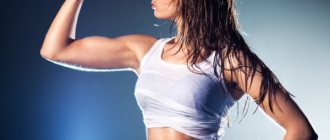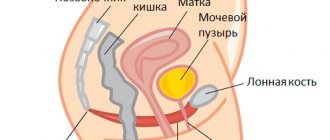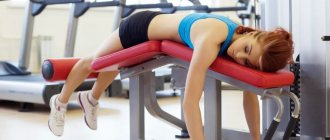The main muscle that is located on the front of the thigh is called the quadriceps or quadriceps muscle. It is she who should be trained to pump the front of the thighs. It is important not to overdo it, so as not to over pump the quadriceps and get additional volume instead of the desired weight loss. The article offers the most effective exercises for the anterior thigh, which are suitable for both beginners and advanced users.
Squats alone are not enough to train your thighs.
Workout Basics
So that physical exercise brings maximum effect and benefit to the body as a whole.
Some training recommendations should be followed:
- Before starting a workout, you should objectively assess the physical condition of your body (if you feel unwell, it is better to postpone the workout for a while, since it will not bring any benefit, but it can cause harm).
- Monitoring your pulse and breathing throughout the entire session is mandatory. The heart rate should not exceed the normal limits for a particular age category and level of physical fitness.
- It is important to adhere to the drinking regime during training (you need to drink purified drinking water without gas).
- You should not eat immediately before training (at least 1.5 hours must pass since your last meal).
- Physical activity should be regular. The optimal number of workouts per week is from three to five.
- It is recommended to start each workout with a warm-up and end with a cool-down.
Warm-up
Before starting intense exercise, you need to warm up. This is necessary in order to avoid injuries during training (sprains, muscles), as well as to prepare the cardiovascular and respiratory systems for active work.
To warm up, it is enough to perform 10-15 exercises of 10-12 repetitions each. When warming up, special attention is required to those muscle groups that will receive the most intense load when performing the main set of exercises.
In this case, these are the leg muscles.
- Starting position No. 1: feet shoulder-width apart, arms along the body. You should take a deep breath, raising your arms up, then slowly exhale completely, while your arms smoothly lower down.
- Tilts the head to the side.
- Tilts the head forward and backward.
- Circular movements of the shoulders.
- Starting position No. 2: feet shoulder-width apart, arms bent at the elbows, located in front of the chest. It is necessary to alternate between moving your arms back, bent at the elbows (returning to the starting position), with moving your straight arms back (returning to the starting position again).
It is best to start exercises on the anterior surface of the thigh with a warm-up. - Starting position No. 3: feet shoulder-width apart, hands on the belt. Bend the torso to the sides.
- Bend forward and backward.
- Starting position No. 3: Perform deep lunges to the side alternately with each leg. When performing the exercise, you need to ensure that your back is straight. In the lower position, the heels are not lifted off the floor, the feet are placed parallel to each other. Lunges are performed slowly, without jerking.
- Lunges forward.
- Circular rotations of the body in each direction 5-8 times.
- Circular rotation of the feet clockwise and counterclockwise for 10-15 seconds. each leg.
- In a standing position, place your right foot on your heel in front of you. Pull the toe towards you and hold this position for 10-15 seconds. They change the leg.
- From a standing position, perform smooth downward bends, trying to touch the floor. In the lower position they linger a little, then return to their original position. The legs do not bend at the knees during the exercise.
Hitch
After intense exercise, it is not recommended to abruptly end the workout; it is necessary to allow the body to smoothly adjust to its normal operating mode. The main task of the cool-down is to bring the pulse, breathing and body temperature to normal levels.
To do this, you should perform cardio exercises (for example, light jogging or walking in place) for 5-7 minutes. When your heart rate and breathing are normal, it is helpful to spend 5-10 minutes stretching.
The main part of the workout should take place in the most intense mode, but without overload. If the heart rate exceeds the permissible values, the load should be reduced.
Contraindications
Arthrosis of the 2nd or 3rd degree is not an obstacle to moderate and dosed physical activity. Doctors may prohibit gymnastics for the following diagnoses:
- high blood pressure;
- severe cardiovascular pathologies;
- inguinal hernias;
- increased body temperature;
- exacerbation of diseases of internal organs;
- recent surgery on the body;
- exacerbation of arthrosis;
- critical days for women.
Have you recently had appendicitis surgery? Postpone gymnastics until your doctor agrees
The best exercises for the front of the thigh
During training, you must ensure that each exercise is performed correctly. Weighting is added gradually.
Squats with dumbbells. Starting position: feet shoulder-width apart, arms with dumbbells (total weight up to 5 kg) lowered down. Dumbbells should be held parallel to the floor.
Exercise technique:
- As you inhale, lower your pelvis down until your thighs are parallel to the floor.
- The support is on the heels.
- In this position, you need to tense your thigh muscles as much as possible and hold for a few seconds.
- Then, exhaling, they return to the starting position.
Stepping onto a support. To perform this exercise, you will need a special fitness platform or any available tool that can replace it, for example, a step or a stool.
Starting position: legs together, back straight, arms down.
Exercise technique:
- As you exhale, step onto the platform with your right foot and place your left foot on it.
- As you inhale, lower your right leg down, then put your left leg down.
- After completing one approach, the supporting leg needs to be changed.
Bulgarian lunges. You will also need a fitness platform to perform this exercise.
Starting position: back to the platform, arms in any position. The right leg, slightly bent at the knee, is placed in front of you. The left leg rests on the platform with the top of the foot.
Exercise technique:
- You need to bend the supporting leg at the knee joint until a right angle is formed between the thigh and shin, the thigh is parallel to the floor, the support is on the heel.
- Make sure that the right knee does not move forward beyond the ankle during the lunge.
- Return to the starting position.
- Do one approach, then change legs.
Lying leg raise. The exercise should be performed lying on the floor on a gymnastic mat.
Starting position: lying on your back, hands under your buttocks, legs straight, lower back pressed to the floor.
Exercise technique:
- As you exhale, raise your right leg up to a right angle with your body.
- Exhaling, return to the starting position.
- After making one approach, repeat the exercise with your left leg.
You can perform leg raises with both legs at the same time, paying special attention to the correct position of the lower back. To enhance the effect of this exercise, you can not lower your legs to the floor after lifting, but hold them at an angle of 10 degrees relative to the floor.
Leg row with expander . To perform this exercise, you will need a rubber expander band; one edge of it must be secured to the support, and the other edge must be attached to the foot.
Starting position: lying on a gymnastic mat, legs extended straight.
Exercise technique:
- Bend the leg on which the expander is attached at the knee until a right angle is formed in the joint.
- Perform one approach and change legs.
"Pistol." When performing this exercise, you can hold on to a support to maintain balance.
Starting position: standing on your left leg. The straight right leg is raised above the floor, the toe is pointing up.
Exercise technique:
- Sit down all the way on your left leg.
- The right leg remains straight and does not touch the floor, with the toe pointing upward.
- Return to the starting position.
- They do one approach, after which they change the supporting leg.
Lifting methods and their features
There are many techniques for restoring healthy skin on your legs. Most in demand:
- RF lifting - the skin is exposed to radio frequency radiation. Cells start the regeneration process and begin to produce collagen and elastin. The result is rejuvenation and improved tone.
- Thread lifting - the doctor outlines a mesh for hip correction and inserts threads along it under the skin. They reliably reinforce the problem area and tighten the skin.
- Mesotherapy is injections of drugs that deeply affect the skin and fat deposits. They have a visible and lasting effect.
- Aikun laser - infrared radiation has a targeted effect on the skin and stimulates cell renewal, improves the quality of the skin, and tightens it.
- Laser rejuvenation is a laser technique aimed at combating increased skin sagging.
- Fractional thermolysis is the effect of a laser pulse on the skin, which stimulates skin renewal and increases its elasticity.
- Biomodeling Profhilo - injections of long-acting filler based on hyaluronic acid of different densities. Rejuvenate and tighten the skin.
- Introduction of fillers - preparations based on hyaluronic acid moisturize the skin and increase its elasticity.
A set of stretching exercises
Exercises for the anterior thigh include more than just strength exercises.
Stretching is a very important element of training; it allows muscles to relax after intense exercise, and also helps to improve the process of breaking down fats in tissues.
To effectively stretch, and at the same time not harm your health, you need to adhere to the following rules:
- Classes must be systematic.
- You should be in the stretching position for at least 10 seconds, gradually this figure can be increased to a minute.
- Breathing should be calm and uniform, without delay.
- You cannot stretch the muscles until pain appears. Only a feeling of discomfort in the muscles, but not pain, is acceptable.
Examples of stretching exercises
Standing anterior thigh stretch. Starting position: standing on your left leg, grab your right ankle with your right hand, bent at the knee.
Exercise technique:
- Smoothly pull the heel of the right foot towards the buttocks and count to 10.
- Slowly lower your leg down.
- Perform the exercise with the second leg.
Stretch the front of the thigh in a lunge position. Starting position: standing on your left knee. The right leg, bent at the knee at a right angle, stands on the floor in a forward position, the heel is pressed to the floor. The elbow of your right hand can rest on your right knee.
Exercise technique:
- The body is moved forward, the pelvis is slowly lowered down.
- Then with your left hand you need to grab your left foot and smoothly pull the heel towards the buttock. Keep your back straight and look forward.
- The heel of the right foot and the left knee do not leave the floor.
- Stay in the stretching position for 10 seconds, then smoothly lower your foot to the floor.
- Repeat the exercise with alternating legs.
Stretch the front of the thigh while sitting. Starting position: sitting on a gymnastic mat, bend your knees all the way and spread them apart.
The feet are pulled as close to the pelvis as possible.
Exercise technique:
- They try to touch their knees to the floor.
- In the maximum position they are held for 10 seconds.
Quadriceps or quadriceps
Let me immediately introduce you to the name of the most important muscle - the quadriceps, or quadriceps. You know, the last name makes me smile, sometimes you say during training “QUADRIIIICEEEPS” immediately in response from the girls: “What? What about censorship?
It all comes from the Latin word “quadriceps”. The muscle is divided into parts, there are 4 of them:
- Vastus medialis muscle
- Lateral wide
- Tailoring
- Straight
Complement:
- Comb
- Long adductor
- Thin
The additional muscles are more related to the inner thigh.
So, let's move on. I don’t want to bore you with boring anatomy and muscle biomechanics, but every person needs to know some points.
A block of exercises to strengthen the muscles of the anterior thigh
Exercises for the anterior thigh can be grouped into one of the blocks of general training. Regularly performing even a few exercises on this muscle group will achieve a noticeable effect.
When performing exercises, you can alternate strength exercises with cardio exercise.
The following block exercises are performed on the front surface of the thigh:
- Squats with dumbbells (perform 45 seconds)
- Step in place (15 sec.)
- Stepping onto a support (45 sec.)
- Running in place with shin overlapping (15 sec.)
- Bulgarian lunges (45 sec.)
- Jumping up in place (15 sec.)
The block of exercises should be repeated in a circle 3-4 times.
Don't miss the most popular article in the section: Morning exercises for those over 40, 50. Gymnastics exercises for weight loss, video lessons.
What exercises are effective for losing weight
All of the above exercises are suitable for losing weight, but you just need to take into account that in order to effectively burn calories during training, you need to avoid long breaks. It is advisable to conduct classes non-stop or with short breaks (up to 10 seconds).
The optimal training regimen for weight loss is block work (alternating strength and cardio exercises).
Why does skin sagging appear?
You will not be able to get rid of loose skin if the reasons that caused it continue to be present. When a woman gets older or hormonal changes occur in her body, her skin changes in its structure, collagen reserves decrease, and metabolic disorders occur. In addition, a layer of fat is deposited. When we talk about sagging and cellulite, we must remember that these two concepts are interrelated.
Such defects can occur as a result of:
- being overweight;
- bad habits;
- irrational, unbalanced nutrition;
- dehydration;
- lack of minerals, vitamins;
- sedentary lifestyle;
- various diseases;
- not very good environmental situation;
- change of age.
A set of exercises for the gym
When training in the gym, the main thing is not to overdo it with the load and not turn your hips into inflated balls (the only exception is the case when this particular form of the quadriceps is the goal).
Exercises for pumping the anterior thigh:
- Squats with a load.
- Front squats with a barbell.
- Hack squats.
- Leg press on the machine.
- Leg extension exercises on a machine.
Inner side
Quick box squats using expanders
- 3 sets of 8-15 reps
- Body part: Quadriceps Equipment: Barbell
Sumo style deadlift
- 3 sets of 8-15 reps
- Body part: Hamstrings Equipment: Barbell
Lunges with a barbell in the Smith machine
- 3 sets of 10 reps
- Body part: Quadriceps Equipment: Barbell
Add to Calendar * Add to My Workouts * Print Workout
* — The service is in beta testing
During training, imagine how the muscles of your legs are growing and how your hips are enlarged. Professional athletes claim that such visualization puts you in the right mood and helps you achieve exactly the result you dreamed of!
You've already done a great job, all you have to do is take a little leap and finish off your regular full-body workout with this thigh routine.
What you need to workout in the gym
When going to the gym for training, you should take with you:
- purified water without gas;
- comfortable clothes;
- closed shoes;
- hygiene products for shower;
- towel.
Performing exercises on the front surface of the thigh does not take much time, but with regular training a positive result is guaranteed.
Article design: Mila Friedan
Conclusions.
- The basic principle of new modifications of the medial thigh lift is the rigid fixation of the moving tissues of the thigh to the periosteum of the body and the branch of the pubic bone.
- The technology of moving and suturing the superficial fascia of the thigh with the periosteum of the pubic bone allows for the most durable fixation of the tissues of the inner surface of the thighs with minimal loss of correction of their position in the postoperative period.
- The modifications we have developed for medial thigh skin tightening allow us to obtain predictable and aesthetically acceptable results: postoperative scars are subject to minimal expansion and there is no dislocation to the thigh.

